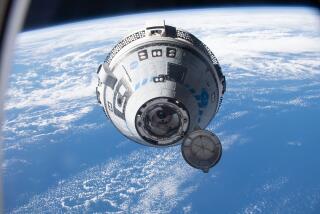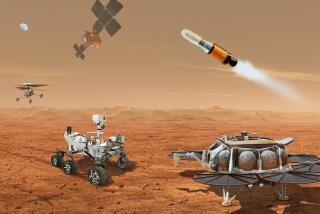NASA considers a final repair mission to Hubble telescope
BALTIMORE — The future of the Hubble Space Telescope hangs in the balance as top NASA managers weigh the feasibility and risks of sending shuttle astronauts on a fifth and final servicing mission to the observatory.
Michael D. Griffin, the agency administrator, is scheduled to announce Tuesday, at Goddard Space Flight Center in Greenbelt, Md., whether he’ll order the mission.
“There is talk about very little else at the moment. Everybody wants to know what’s happening,” said Matt Mountain, director of the Space Telescope Science Institute in Baltimore, which manages Hubble science. “This is basically going to renew the telescope that is so very critical to us.”
If Griffin says “go,” the mission could launch as early as 2008, providing 7,000 astronomers worldwide with five more years of access to the famous telescope -- along with better instruments to explore the depths of the universe and its evolution.
But a Hubble mission would also be the only flight before the shuttle’s retirement in 2010 that could not reach the International Space Station in case of emergency. That scenario has worried NASA since 2003, when the shuttle Columbia was damaged by debris on liftoff and burned up during reentry. All seven crew members died.
Griffin has said he might support a manned Hubble repair, but only after two safe post-Columbia missions. NASA has now flown the shuttle safely three times since then.
The agency has also reduced the shedding of insulating foam -- debris that damaged and doomed Columbia. In addition, crews have proved they can inspect and repair minor damage to their heat shields in orbit.
Still in question -- and a likely topic of a meeting today in Washington -- is whether NASA could launch a second shuttle on short notice to rescue a crew marooned on a Hubble mission. That was a recommendation of the Columbia Accident Investigation Board.
Griffin’s predecessor, Sean O’Keefe, canceled further servicing missions in 2004, concluding that the scientific reward was not worth the risk to astronauts’ lives.
“The scientific community has high expectations that the effort that’s been invested so far in Hubble will be used,” said Preston M. Burch, Hubble program manager at Goddard. “So if we were not to do it, it’s going to be a huge disappointment.”
Just keeping Hubble active a few years longer would allow scientists to capture the unexpected, said Mario Livio, a senior astronomer at the space telescope institute.
“If we do not have a telescope like Hubble, with its sharp vision and sensitivity, we may miss out on some very important cosmic events,” he said.
A series of scientific panels convened after O’Keefe’s cancellation concluded Hubble was worth preserving. But it was Griffin’s 2005 appointment that turned the tide. As a physicist and engineer who had moved to NASA from the Johns Hopkins Applied Physics Lab, he seemed more attuned to the scientists’ pleas.
“Everybody has enormous respect for Mike Griffin,” Burch said. “He is probably, technically, the most astute administrator NASA has ever had.”
Said Livio: “If he will decide not to service Hubble, it will probably be for some very good safety reason. Clearly, we will not only accept but respect any decision he will reach.”
More to Read
Sign up for Essential California
The most important California stories and recommendations in your inbox every morning.
You may occasionally receive promotional content from the Los Angeles Times.










